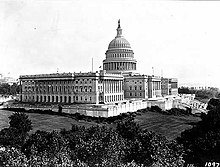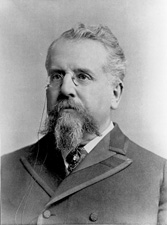53rd United States Congress
| 53rd United States Congress | |
|---|---|
52nd ← → 54th | |
 United States Capitol (1906) | |
March 4, 1893 – March 4, 1895 | |
| Members | 88 senators 356 representatives 4 non-voting delegates |
| Senate majority | Democratic |
| Senate President | Adlai E. Stevenson |
| House majority | Democratic |
| House Speaker | Charles F. Crisp |
| Sessions | |
| 1st: August 7, 1893 – November 3, 1893 2nd: December 4, 1893 – August 28, 1894 3rd: December 3, 1894 – March 3, 1895 | |
The Fifty-third United States Congress was a meeting of the legislative branch of the United States federal government, consisting of the United States Senate and the United States House of Representatives. It met in Washington, D.C. from March 4, 1893 to March 4, 1895, during the fifth and sixth years of Grover Cleveland's presidency. The apportionment of seats in the House of Representatives was based on the Eleventh Census of the United States in 1890. Both chambers had a Democratic majority.
Party summary
The count below identifies party affiliations at the beginning of the first session of this Congress, and includes members from vacancies and newly admitted states, when they were first seated. Changes resulting from subsequent replacements are shown below in the "Changes in membership" section.
Senate
- Democratic: 44 (majority)
- Republican: 37
- Populist: 3
- Silver: 1
- Vacant, due to failure to elect. Later filled by Republicans: 3
TOTAL members: 88
House of Representatives
- Democratic: 211 (majority)
- Republican: 133
- Populist: 11
- Independent Democratic: 1
TOTAL members: 356
Leadership

Adlai Stevenson
Senate
- President: Adlai Stevenson (D)
- President pro tempore: Charles F. Manderson (D)
- Isham G. Harris (D), elected March 22, 1893
- Matt Whitaker Ransom (D), elected January 7, 1895
- Isham G. Harris (D), elected January 10, 1895
House of Representatives

Charles F. Crisp
- Speaker: Charles F. Crisp (D)
Major events
- March 4, 1893 Grover Cleveland became President of the United States for a second time.
- May 5, 1893: Panic of 1893: A crash on the New York Stock Exchange started a depression.
- November 7, 1893: Colorado women were granted the right to vote
- May 1, 1894: Coxey's Army, the first significant[to whom?] American protest march, arrived in Washington, D.C.
Major legislation

- July 16, 1894: Utah Enabling Act
- August 27, 1894: Wilson–Gorman Tariff Act
- February 18, 1895: Maguire Act of 1895
Members
This list is arranged by chamber, then by state. Senators are listed in order of seniority, and Representatives are listed by district.
Senate
Senators were elected by the state legislatures every two years, with one-third beginning new six-year terms with each Congress. Preceding the names in the list below are Senate class numbers, which indicate the cycle of their election. In this Congress, Class 1 meant their term began in this Congress, requiring reelection in 1898; Class 2 meant their term ended in this Congress, requiring reelection in 1894; and Class 3 meant their term began in the last Congress, requiring reelection in 1896.
House of Representatives
Changes in membership
The count below reflects changes from the beginning of the first session of this Congress.
Senate
- replacements: 6
- Democratic: no net change
- Republican: no net change
- Liberal Republican: 1 seat net loss
- deaths: 4
- resignations: 8
- interim appointments: 2
- Total seats with changes: 12
House of Representatives
- replacements: 21
- Democratic: 1 seat net loss
- Republican: 1 seat net gain
- deaths: 11
- resignations: 17
- contested election: 3
- Total seats with changes: 31
Employees
Senate
- Chaplain of the Senate: William H. Millburn (Methodist)
- Secretary of the Senate: Anson G. McCook
- William R. Cox, elected April 6, 1893
- Sergeant at Arms of the Senate: Edward K. Valentine
- Richard J. Bright, elected August 8, 1893
House of Representatives
- Chaplain of the House
- Samuel W. Haddaway (Methodist)
- Edward B. Bagby (Christian), elected December 4, 1893
- Clerk of the House: James Kerr
- Doorkeeper of the House: Alvin B. Hurt
- Postmaster of the House: Lycurgus Dalton
- Clerk at the Speaker’s Table: Charles R. Crisp
- Sergeant at Arms of the House: Herman W. Snow
References
- Martis, Kenneth C. (1989). The Historical Atlas of Political Parties in the United States Congress. New York: Macmillan Publishing Company.
{{cite book}}: Cite has empty unknown parameter:|coauthors=(help) - Martis, Kenneth C. (1982). The Historical Atlas of United States Congressional Districts. New York: Macmillan Publishing Company.
{{cite book}}: Cite has empty unknown parameter:|coauthors=(help)



